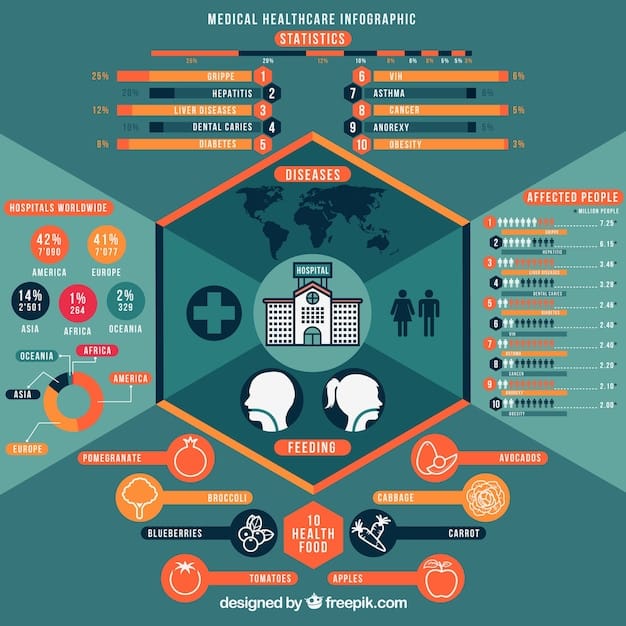Claiming Dependents: Your Guide to 2025 Tax Savings

How Claiming Dependents Can Reduce Your 2025 Tax Bill: A Comprehensive Guide explores the criteria for claiming dependents, including qualifying child and qualifying relative tests, and illustrates how these deductions can significantly lower your tax liability.
Navigating tax season can be daunting, but understanding how to claim dependents is a crucial step in reducing your tax liability. This guide, How Claiming Dependents Can Reduce Your 2025 Tax Bill: A Comprehensive Guide, provides a clear and accessible overview of the rules and regulations you need to know.
Understanding Tax Dependents
Claiming dependents can be a valuable way to reduce your tax bill. However, it’s important to understand who qualifies as a dependent under IRS rules. Let’s break down the criteria.
Knowing the rules can mean significant savings. Making sure you meet the criteria is the first step.
Qualifying Child vs. Qualifying Relative
The IRS distinguishes between two types of dependents: a qualifying child and a qualifying relative. Each has its own set of rules.
The distinction is vital for tax purposes. Failing to categorize correctly can lead to issues.
- Qualifying Child: Must meet age, residency, and relationship tests.
- Qualifying Relative: Broader relationship criteria, focusing on support and gross income tests.
- Key Differences: Age limit and residency rules are stricter for a qualifying child.
This separation allows the IRS to standardize claims. This reduces the likelihood of fraudulent claims.
In summary, the key difference between a Qualifying Child and a Qualifying Relative lies in the relationship, age, residency, and support requirements. Meeting one set of criteria is not the same as meeting the other; therefore, understanding the nuances between the two is essential for maximizing tax benefits.

The Qualifying Child Test: A Detailed Breakdown
To claim someone as a qualifying child, they must meet several specific tests. These tests are designed to ensure the individual is genuinely dependent.
These requirements prevent tax fraud. By setting the guidelines in stone, the tax office hopes to avoid abuse. These rules also help to ensure that the child is being supported.
Age Test
The child must be under age 19, or under age 24 if a full-time student, or any age if permanently and totally disabled.
The difference in age cut off can be confusing, but the guidelines are clear. Age plays a pivotal role in determining dependency.
Residency Test
The child must live with you for more than half the year. Temporary absences for school, vacation, or medical care are generally allowed.
- What Counts as Home: Your main home is where the child resides for the majority of the year.
- Exceptions: Absences for education or medical treatment don’t disqualify them.
- Documentation: It’s wise to keep records of residency to prove eligibility.
The residency tests help differentiate between temporary visitations and actual residencies. Parents should always monitor how long and when their children are with them, to avoid confusion.
In conclusion, the Qualifying Child Test involves age, residency, and relationship tests. Meeting one component of this test is not the same as meeting the others, so careful consideration of the details of a specific child’s life is the first step in determining tax liability.
The Qualifying Relative Test: More Flexibility?
The qualifying relative test offers a bit more flexibility but also has its own set of stringent requirements. This applies to individuals who may not meet the “child” criteria but still rely on you for support.
More people, generally, are able to meet the requirements of this rule. It’s still important to follow the suggestions carefully. The IRS is not lenient, and tax fraud will be prosecuted.
Gross Income Test
The relative’s gross income must be less than $4,700 for 2024 (this amount may change for 2025). This income includes nearly all types of income, unless specifically excluded.
It is critical to monitor the income. If the relative’s income is above the suggested number, you will probably not be able to claim them.
Support Test
You must provide more than half of the relative’s total support during the year. This includes housing, food, medical care, and other necessities.
The support test has many layers, so it is important to be sure you meet the threshold: half, or more, of the relative’s support. Keeping track will serve you well when tax season comes.
- What Counts as Support: Includes housing, food, medical expenses, and education.
- Multiple Support Agreement: Allows multiple people to collectively provide more than half the support.
- Documentation: Keep records of all support provided throughout the year.
Always record the expenses. Making certain the expenses are recorded can help prevent any issues later on. Not recording may limit your ability to claim exemptions.
To summarize, the Qualifying Relative Test is an important tool for those who support individuals who aren’t children. Understanding the ins and outs of the Gross Income and Support tests will help you make sure you are in compliance.

Calculating the Tax Benefits
Claiming a dependent can lead to several tax benefits, including the child tax credit, the credit for other dependents, and potential deductions.
Knowing how to calculate the specifics is essential. Always make certain you are using accurate estimates. Otherwise, you can experience penalties.
Child Tax Credit
For each qualifying child under age 17, you may be eligible for the child tax credit. The maximum credit amount is subject to change, so check the IRS guidelines for 2025.
Always ensure that the child is under the suggested age, or you won’t be able to claim them. Do not assume the same rules from year to year, as tax credits are subject to reform.
Credit for Other Dependents
If your dependent doesn’t qualify for the child tax credit, you may be able to claim the credit for other dependents. This credit is also subject to change.
- Credit Amount: The maximum credit amount varies annually, so confirm the latest figure for 2025.
- Eligibility: Available for dependents who don’t meet child tax credit criteria.
- Phaseouts: Income phaseouts may reduce or eliminate the credit.
Tax credits can reduce your bill, so it is important to know what’s available. Even a small credit can make a big impact, but be sure you are eligible. Never assume.
The Child Tax Credit and the Credit for Other Dependents are both important for tax savings. However, depending on your eligibility, you may qualify for both. Understanding the credits is essential.
Common Mistakes to Avoid
Failing to accurately claim dependents can lead to IRS scrutiny, penalties, or loss of tax benefits. Here’s what to be mindful of.
You want to avoid scrutiny from the IRS. Accuracy is key to avoiding errors in tax filings. Careful and conservative approaches will mitigate the risks and errors.
Double Dipping
Only one person can claim a child as a dependent. If multiple individuals are eligible, specific tiebreaker rules apply.
If you are unsure who is claiming the child, discuss benefits with your family. Only then will you understand who should be claiming the child in question. If they are being claimed twice, one party will have to amend, and pay penalties.
Incorrect Information
Make sure you have the dependent’s correct social security number and other personal information.
- Verify Information: Double-check the accuracy of information to prevent errors.
- IRS Matching: The IRS cross-references data to catch discrepancies.
- Consequences: Incorrect info can lead to delayed processing or denied claims.
The data must be exact. The slightest variation will raise a red flag. The IRS relies on cross-referencing data between claimants, and making sure it’s exact will make filings much easier.
Avoiding common errors is essential to making sure you don’t run into problems with the IRS. Mistakes can lead to a loss of significant credits and other problems going forward. Always be careful and conservative when claiming dependents, especially if you are unsure.
Planning Ahead for 2025
Tax planning is a year-round activity. Being proactive can help you maximize your tax benefits when claiming dependents.
Preparing and planning ahead for the tax year may help avoid any unexpected issues. Make sure you and your tax filer are always on the same page.
Keep Detailed Records
Maintain thorough records of all support you provide, including receipts, invoices, and other relevant documents.
Recording every detail is recommended to mitigate any risk and provide a comprehensive support of a tax filing. In almost every circumstance, more data is better.
Consult with a Tax Professional
If you have complex tax situations, it’s always a good idea to seek guidance from a qualified tax professional. They can provide personalized advice based on your specific circumstances.
- Professional Insight: Tax pros offer expertise for intricate tax matters.
- Custom Advice: They provide tailored guidance based on your financial situation.
- Staying Compliant: Ensure you’re following the most current tax rules and regulations.
A tax lawyer, or filer with advanced credentials, can help navigate any possible complexities. Many issues can come up during tax season, especially when claiming dependents. It may be in your interests to seek their professional help.
The better prepared you are, the more likely you will be to ensure your taxes are done correctly. Staying proactive will help you avoid any mistakes and allow you to maximize all tax benefits.
| Key Point | Brief Description |
|---|---|
| 🧒 Qualifying Child | Meets age, residency, and relationship tests. |
| 👨👩👧👦 Qualifying Relative | Broader criteria; focuses on support and income. |
| 💰 Child Tax Credit | For qualifying children under 17; amount varies. |
| 🧾 Support Test | You must provide over half of the dependent’s support. |
Frequently Asked Questions (FAQ)
▼
A qualifying child must be under age 19, or under age 24 if a full-time student. There’s no age limit if the child is permanently and totally disabled.
▼
Support includes expenses like housing, food, medical care, education, and clothing. Calculate the total expenses, then determine how much you contributed.
▼
Yes, if they meet the qualifying relative tests, including the gross income and support tests, you may be able to claim them even if they live in a nursing home.
▼
The IRS has tiebreaker rules. Generally, the parent with whom the child lived the most during the year has priority. If the child lived equally with both parents, the parent with the higher adjusted gross income can claim the child.
▼
Consult the official IRS website or publications for the latest updates. These resources will have detailed information on credits, deductions, and eligibility requirements for the 2025 tax year.
Conclusion
Understanding how claiming dependents can reduce your 2025 tax bill is crucial for effective tax planning. By staying informed of the rules and accurately documenting your support, you can maximize your tax benefits and ensure compliance with IRS regulations. Remember to consult with a tax professional for personalized advice tailored to your specific situation.





